Yvoire 作者: 来源: 发布时间:2021-09-27
I.Population and Area
Region: Rhône-Alpes
Department: Haute-Savoie
Code Insee : 74315
Code postal : 74140
Total Area: 3.12km²
Population in 2017: 993
Population Density: 318 /km²
Location: The altitude of the city hall of Yvoire is approximately 374 meters. Its surface area is 3.12 km². The latitude and longitude of Ges are 46.369 degrees North and 6.326 degrees East. The towns and villages near Yvoire are: Nernier (74140) at 1.53 km, Excenevex (74140) at 2.48 km, Messery (74140) at 3.16 km, Massongy (74140) at 5.90 km, Sciez (74140) at 5.92 km.
Histogram of demographic change
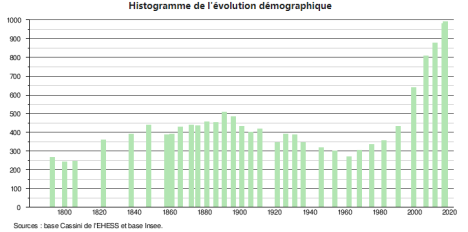
Sources :http://www.cartesfrance.fr/carte-france-ville/74315_Yvoire.html
II.Natural Geography
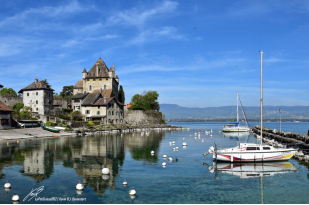
Geographical environment: Yvoire is a small medieval town in the department of Haute-Savoie, in the southeastern French region of Auvergne-Rhône-Alpes. It is located 24 kilometers (14.9 miles) northeast of Geneva. Located at the tip of the Leman peninsula (presqu'île de Léman), Yvoire delimits the two main parts of Lake Geneva, the "petit lac" and the "grand lac".
Climat: The Yvoire lies on 369m above sea level Yvoire's climate is classified as warm and temperate. The rainfall in Yvoire is significant, with precipitation even during the driest month. This climate is considered to be Cfb according to the Köppen-Geiger climate classification. The average annual temperature in Yvoire is 10.2 °C (50.3 °F). Precipitation here is about 919 mm(36.2 inch) per year. The least amount of rainfall occurs in April. The average in this month is 63 mm( 2.5 inch). In November, the precipitation reaches its peak, with an average of 93 mm (3.7 inch). The temperatures are highest on average in July, at around 19.6 °C (67.3 °F). At 0.9 °C( 33.6 °F) on average, January is the coldest month of the year.
Lake Geneva (Lake Leman): Lake Geneva is the largest body of fresh water in western Europe, with an area of 362 sq. miles (216 sq. miles in Switzerland and 146 sq. miles in France) and contains 89 billion cubic yards of water. It is principally fed by the Rhone, which flows from one end to the other and leaves the lake at Geneva. The lake forms an elongated crescent between the mountainous landscapes of the Alps and the Jura. Its northern and southern sides are only 2.5 miles apart in the “little lake” to the west, but more than 8 miles apart in the “large lake” between Morges and Amphion. The waters are deepest, 1017 ft. in the “upper lake” to the east between Lausanne and Evian. The lake has a great moderating influence on the climate of the region and acts as a bird sanctuary.
Transport:
(1) Tranportations: Transportation to Yvoire is easy. It is a simple half hour drive from Geneva or a fast 20-minute passenger ferry crossing from Nyon. CGN Lake Geneva pleasure cruise boats also frequently call in Yvoire. Yvoire bus day tours can also be arranged from most cities along Lake Geneva.
(2) Airports: The closest Airports of Yvoire are: Chambéry Airport (CMF) 88.13km,Dole–Jura Airport (DLE) 101.76km,Lyon-Saint Exupéry Airport (LYS) 120.07km. You can reach Yvoire from this Cities by Plane: London (STN), Athens (ATH), Paris (ORY), Birmingham (BHX), Edinburgh (EDI), Málaga (AGP), Porto (OPO), Casablanca (CMN), Gothenburg (GOT), Toulouse (TLS), Nantes (NTE), Strasbourg (SXB), Oujda وجدة (OUD), Marseille (MRS), Frankfurt am Main (FRA), Tunis (TUN), Agadir (AGA), Oran (ORN), Heraklion (HER), Dubai (DXB) Show all airports.
(3) Ports: The port of Yvoire provides links with the main ports of Lake Geneva, in particular Nyon, Geneva and Lausanne on board the ships of the Compagnie générale de navigation.
Sources : https://en.climate-data.org/europe/france/rhone-alpes/yvoire-213954/
III.Economy
Yvoire Accounting income in 2018 was 409 960 €, or 405 € per inhabitants.
Self-financing capacity in 2018 was 423 070 €, or 418 € per inhabitants.
Income: According to Insee, in 2014, the inhabitants of Yvoire earn on average € 3 513 net per month, or € 42 156 net per year, much higher than average income in France.
Unemployment rate: In 2016, its unemployment rate was 12.7%, which was higher than the French average of 11%.
Companies: In 2017, the total number of companies in Yvoire was 80, and there were 16 new companies.
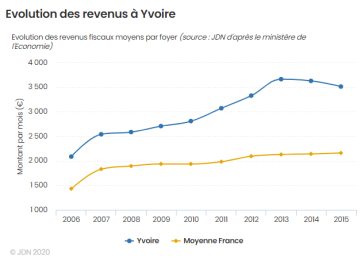
Evolution of average monthly net wages
Sources :
http://www.journaldunet.com/management/ville/yvoire/ville-74315/budget
http://www.journaldunet.com/business/salaire/yvoire/ville-74315
http://www.journaldunet.com/management/ville/yvoire/ville-74315/entreprises
IV.Industrial Characterisitics
This medieval village, which, at the start of the 20th century was home to the fishing industry, is today featured on the official list of France’s most beautiful villages. Yvoire is hugely popular with day-trippers and thus has a large number of restaurants, cafés, boutiques, art galleries, studios, and souvenir shops.
Tourism: Yvoire is one of the 48 towns classified as a “tourist town” in the department. She has been a member of the "Les Plus Beaux Villages de France" association since 1982. In 2014, the town's reception capacity, estimated by the Savoie Mont Blanc organization, was 990 tourist beds in 92 establishments. Accommodation is distributed as follows: 3 furnished; 5 hotels and two outdoor accommodation establishments.
Food Industry: As a traditional fishing village, due to its unique geographical location, Yvoire has various restaurants. Here, you can savor fish from Lake Geneva and enjoy numerous other possibilities to feed your appetite.The famous culinary specialty of Yvoire is perch. Besides, you can taste Arctic char or Fera, accompany with a glass of Crépy, white wine produced in Chablais nearby Douvaine, not far from Yvoire.
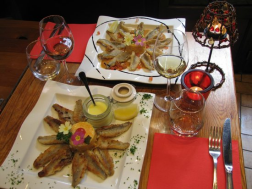
Sources:
https://yvoire-france.com/yvoire-the-top-10-things-to-do/local-specialties-yvoire/
V.Attractions
1.The garden of five sens
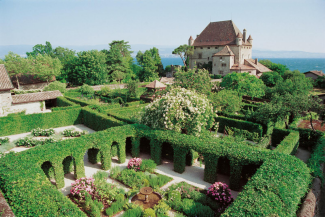
In the heart of the village, don’t miss the occasion to visit the Garden of Five Senses classified “Remarkable Garden” by the Ministry of Culture. This little piece of green heaven invites you to a poetic discovery of the plants with your five senses.
Inspired by the poetic atmosphere of the labyrinths of the Middle Ages, several intimate gardens with evocative names invite to the awakening of the senses and discovery: Garden of Taste, garden of the Odorate, cloister of medicinal plants, alpine meadow... Each universe is a tribute to the richness of the plant world.
No less than 1500 varieties evolve over the seasons for the pleasure of each. Legendary plants, foliage with astonishing textures, collection of fragrant plants, curiosity of vegetables, roses... Everyone comes at his own pace for a sensory walk in the heart of a living work patiently chiseled. Everything is made for your pleasure: the pleasure of your eyes with the colorful landscape provided by the arrangement of the flowers, the pleasure of stroking the softness of the foliage, the pleasure of smelling the roses, the pleasure of listening to the birds and the whispering of the water, the pleasure of finally going back to the true tastes of your childhood.
Website: https://www.jardin5sens.net/en/
Location: Rue du Lac, 74140 Yvoire, France
Source: https://www.france-voyage.com/tourism/claude-monet-house-gardens-1779.htm
2.Park of the Domaine de Rovorée - La Châtaignière
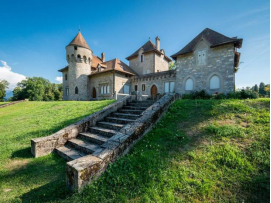
On nearly 24 ha, with a lakeside facade of 1 km 200, the site of Rovorée - La Châtaignière is a set of 2 public properties, belonging to the General Council of Haute-Savoie and the Conservatory of Coastal Space and Lacustrine Shores. Sensitive natural area, place of welcome for the family relaxation and the walk, marked out routes. A remarkable ensemble of centuries-old chestnut trees, this property is accessible by foot via the green route from the medieval village of Yvoire, or by the solar shuttle set up during the summer period. An exhibition is organized each year by the General Council from June to September.
Sensitive natural area of 24 hectares, the Domaine de Rovorée - La Châtaignière spreads its forest landscape along Lake Geneva, near the village of Yvoire.
The estate is one of the largest natural sites accessible to the public on the French side of Lake Geneva. It is not a landscaped urban park but a sensitive natural area with an ancient forest with its old chestnut trees, lake shores with tuff caves and medieval remains, forest and shore birds and a panorama splendid on Lake Geneva.
The absence of contemporary brands preserves the magical charm of these landscapes, shaped over the centuries by human practices and offers lovers of nature and calm, a unique site including its magnificent chestnut rooted for two centuries in this preserved place.
The estate includes a wide variety of landscapes: tufa resurgences, meadows, hedges, wooded areas, shores of the lake... These contrasts explain the richness of local biodiversity. There are no less than 350 plant species, 87 species of birds, 29 species of butterflies and 13 species of bats!
Every year, free nature discovery activities are offered from April to October by the Department and its partners, to allow you to discover the richness of the site in a fun, artistic and unusual way, as well as an exhibition that links nature and culture.
Location: Unnamed Road 74140, Yvoire, France
Source: https://www.france-voyage.com/cities-towns/yvoire-29995/park-domaine-rovoree-chataigniere-37064.htm
https://www.france-voyage.com/tourism/yvoire-469.htm
3.Yvoire Castle (Château d'Yvoire)
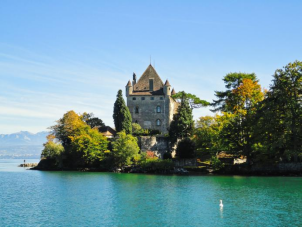
Yvoire Castle, locally known as Château d'Yvoire, lies on the southern shore of Lake Geneva (Lac Léman in French), in the Haute-Savoie department in France.
Yvoire Castle was built in the early 14th century by Amadeus V, Count of Savoy. From 1306 he fortified the entire village as it was situated on a strategic location on a point between the "small lake" and the "large lake" that form Lake Geneva. For half a century, the village of Yvoire had an important military role, which earned certain freedoms for its inhabitants in 1324. During the 16th century, from 1536 to 1591, the region was occupied by forces of the independent city of Bern, who were allies of the French and the independent city of Geneva. During this occupation the village lost its ramparts and military role. Yvoire Castle was burnt and remained roofless for 350 years. In 1655 the castle was acquired by the d'Yvoire family. Between 1919 and 1939 they had the castle restored and gave it a new roof and 4 corner turrets.
Château d’Yvoire still dominates the small town today, as it must have done back in the Middle Ages. The castle is a typical Savoy design and reminds of many other medieval castles in the Lac Léman region. Yvoire Castle looks the part with turrets, towers, few windows, and thick walls. It has a commanding position right on the banks of Lake Geneva from where it guards the small fishing boat and large modern yacht harbors.
Even on moderately clear days, Yvoire Castle can be seen from towns such as Nyon, Prangins, and Gland on the Swiss side of Lake Geneva.At present Yvoire Castle is private property so that it can not be visited. A nice castle on a beautiful location in a cosy medieval town.
Location: Rue du Lac, 74140 Yvoire, France
Source: https://www.castles.nl/yvoire-castle
4.Church Saint-Pancrace
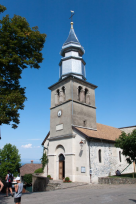
The Saint-Pancrace Church of Yvoire is a Catholic church dedicated to Saint Pancrace, who suffered martyrdom in Rome in the 3rd century. Classified Historical Monument, it is a must of your visit in the village.
The church of Yvoire, dedicated to Saint Pancrace, probably dates back to the 11th century and was transformed several times. In 1250, the church was submitted to the authority of the nearby abbey of Filly. It is a small vaulted chapel parallel to the rampart located in front of the current choir and presbytery. Between 1536 and 1598, the Chablais was invaded by the Bernese and converted by force to the Reformed religion. The Chablais would be reconverted by Saint François de Sales and the church restored with a baroque altar. The nave, perpendicular to the original chapel, is constructed in the 17th century. The cemetery located in the presbytery garden is moved in 1834 to the outside of the village during the extension of the church in the 19th century.
The current bell tower built between 1856 and 1858 belongs to the line of bell towers that characterize the Savoyard religious architecture of the late nineteenth century. Initially covered with tinned iron, the municipality considered its restoration as early as 1983 to fight against rust. This bell gable, distinctive feature of roman style chapels, had been one of the 800 bell towers of the region to have been destroyed by Albitte during the French revolution in order to dissolve them to build cannons for Napoleon’s army. Repaired in 1934, the bell tower was covered with stainless steel in 1989. This is what gives it this shining aspect, like a lighthouse on Lake Geneva. The top is covered with gold leaves coming from one of the last gold miller in France located in Excenevex, near Yvoire.
Location: Rue de l'Église, 74140 Yvoire, France
Source: https://www.france-voyage.com/cities-towns/yvoire-29995/church-saint-pancrace-37061.htm
https://yvoire-france.com/yvoire-the-top-10-things-to-do/church-yvoire/
5.Fishing Harbour of Yvoire
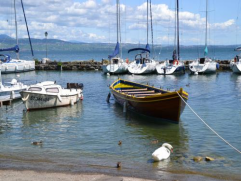
Boaters and tradesmen share the wharves located below the church where the fishermen's harbor is like a bubble out of time a quiet and peaceful corner, frequented by local wildlife.
As much to facilitate the work of fishermen as boatmen, that to protect the banks, protective dikes and ports were developed: the first port was that of fishermen located below the church and built in the early nineteenth century, built by the fishermen themselves.
It was destroyed by the lake and rebuilt in the 1860s. At that time, paddle steamers already cruised Lake Geneva, but they could not dock at the pier of the small port. Thus, the passengers had to embark and disembark by borrowing a wooden pontoon which prolonged the short stone pier still visible today at the foot of the castle.
Location: 74140 Rue du Lac, 74140 Yvoire, France
Source: https://www.france-voyage.com/cities-towns/yvoire-29995/fishing-harbour-yvoire-37060.htm
VI.History
Yvoire’s written history goes back to 1306 and a time when Lake Geneva castles played an important role in protecting the strategic trade routes through the Alps and along the lake. However, changing trade routes pushed Yvoire into decline and relative obscurity since the sixteenth century. It is only the onslaught of mass tourism during the twentieth century that placed Yvoire back on the map as a popular day-trip destination for travelers in the Lake Geneva region.
Yvoire was originally a fishing little harbour overlooked by the square keep of its castle. In the 14th century, Amadeus V, Count of Savoy, understood the strategic location of Yvoire in the region of Geneva and had the village fortified during the war between Savoy and the French province of Dauphiné. Yvoire played an important military role and its inhabitants were give tax privileges in 1324. From 1536 to 1591, the village and its surroundings were occupied by the Bernese, allies of the French and Geneva. Yvoire was pillaged and its fortifications dismantled. The castle was also severely damaged and stayed roofless for 350 years. Until the 1950s the village was inhabited by farmers and fishermen and was not an important tourist destination.
Sources: https://frenchmoments.eu/yvoire-haute-savoie/
https://www.france-voyage.com/cities-towns/giverny-7978.htm
VII.Other information
The garden of five sens in Yvoire was awarded the Remarkable Garden label upon its creation by the Ministry of Culture and Communication. Valid for 5 years, the label was again awarded in 2010 and 2015 to the Garden.
Yvoire received his 1st flowering award in 1959. The national flowering award has since been regularly renewed and Yvoire is now classified as "4 flowers".
Sources : https://visit-yvoire.com/village-yvoire/fleurs-vieilles-pierres-yvoire/
https://jardin5sens.net/jardin-remarquable/
VIII.Contact information
Address of Yvoire town hall:
Mairie de Yvoire
3, place de la Mairie
74140 Yvoire
Phone number: 04 50 72 80 36
Fax: 04 50 72 91 61
E-mail: mairie.yvoire@wanadoo.fr
Website: http://www.cc-baschablais.com
Mayor : Jean-François Kung (Mandat : 2014-2020)
Sources : http://www.cartesfrance.fr/carte-france-ville/74315_Yvoire.html#mairie
